Until someone invents a device to teleport humans from one side of the Earth to the other, this is the next best thing.
An experimental research flight operated by Australian airline Qantas touched down in Sydney on Friday, after flying nonstop from London – a journey that pushes the frontier of modern aircraft capabilities – smashing two aviation records and witnessing a rare double sunrise along the way.
Flight QF7879 became the world’s longest passenger flight by a commercial airline both for distance, at 17,800 kilometers (about 11,060 miles), and for duration in the air, at 19 hours and 19 minutes.
The achievement could help usher in a new generation of so-called ultra long haul flights that will directly connect far-flung Sydney with destinations across Europe and the United States.
The 50 or so people onboard departed London’s Heathrow on Thursday in the pitch dark of pre-dawn, having sucked down their last lungfuls of rain-drenched November air.
Two sunrises later, they emerged blinking into a bright, warm Friday afternoon on the east coast of Australia. At least three whole hours sooner than if they’d had to change aircraft en route.
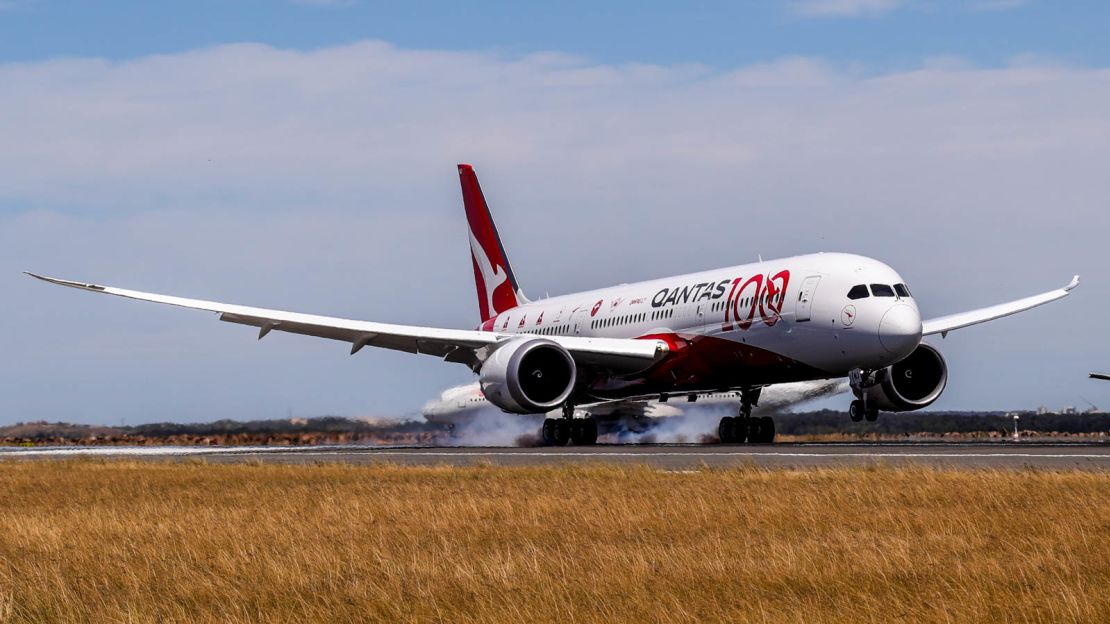
It’s not a service fare paying passengers can buy tickets for yet. Qantas hopes to make it part of its regular schedule by 2022 or 2023, but before that happens it’s got to convince Australian aviation regulators that pilots, cabin crew and passengers can cope with up to 22 hours in the air without a break.
The airline calls its plan, which also includes regular New York-Sydney flights, “Project Sunrise.” The airline’s chief exec, Alan Joyce, describes it as the “last frontier” of commercial flying.
Flight QF7879 from London is one of three research trips being undertaken by the airline to gather data to present to Australia’s Civil Aviation Safety Authority. During these flights, pilots wear brainwave monitors and have their urine tested in the weeks before and after the flight to track levels of melatonin, a hormone that controls sleep cycles.
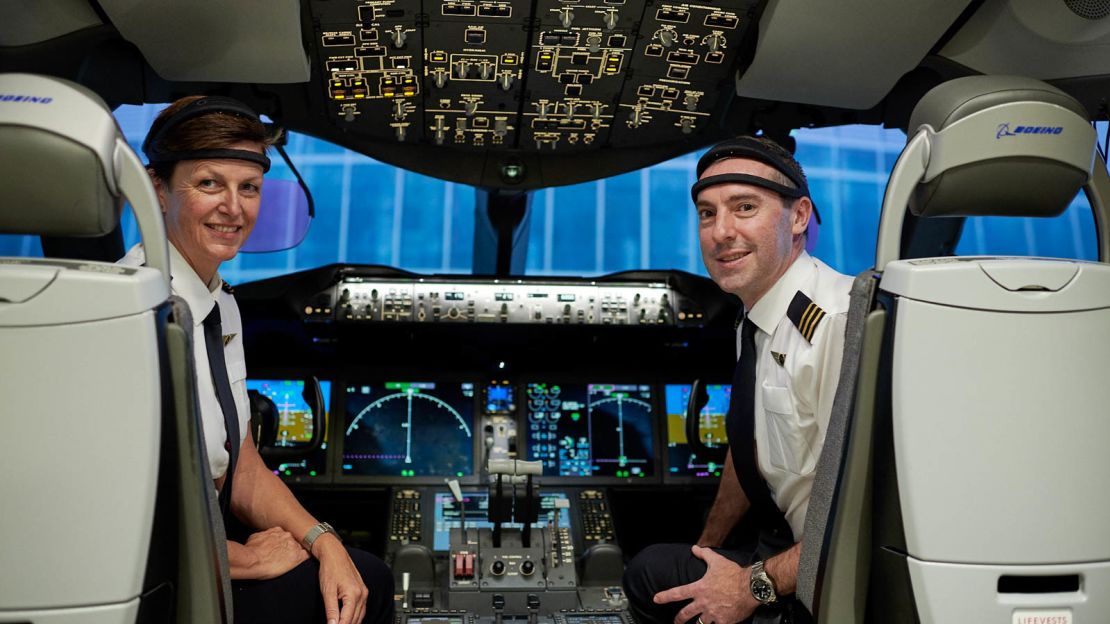
Other passengers, mainly Qantas employees and frequent fliers, wear biometric monitors during the flights to record sleep patterns, physical activity and even inflight entertainment consumption.
Also on board the factory-fresh 787-9 Dreamliner were a handful of journalists, CNN included. Qantas has shrewdly used the test flights as headline-generating publicity ops.
The plane’s landing in Sydney was timed to coincide with the eve of Qantas’s 99th anniversary and hundreds of employees turned out to greet it at a specially organized celebration.
CEO Joyce says a decision on whether it’ll go ahead with the “Sunrise” flights will be made at the end of the year. That’ll depend on the regulators and getting the right aircraft to make it economically viable – currently Boeing’s 777X-9 and Airbus’s A350-1000 are both in the frame.
It’ll also depend on whether customers are willing to endure the full nonstop journey.
If they are, flight QF7879 should give them a taster of what to expect.
CNN’s Richard Quest was there to experience it all, and reveals what happened on board:
Pre-flight – 5 a.m. London. 6 p.m. Sydney
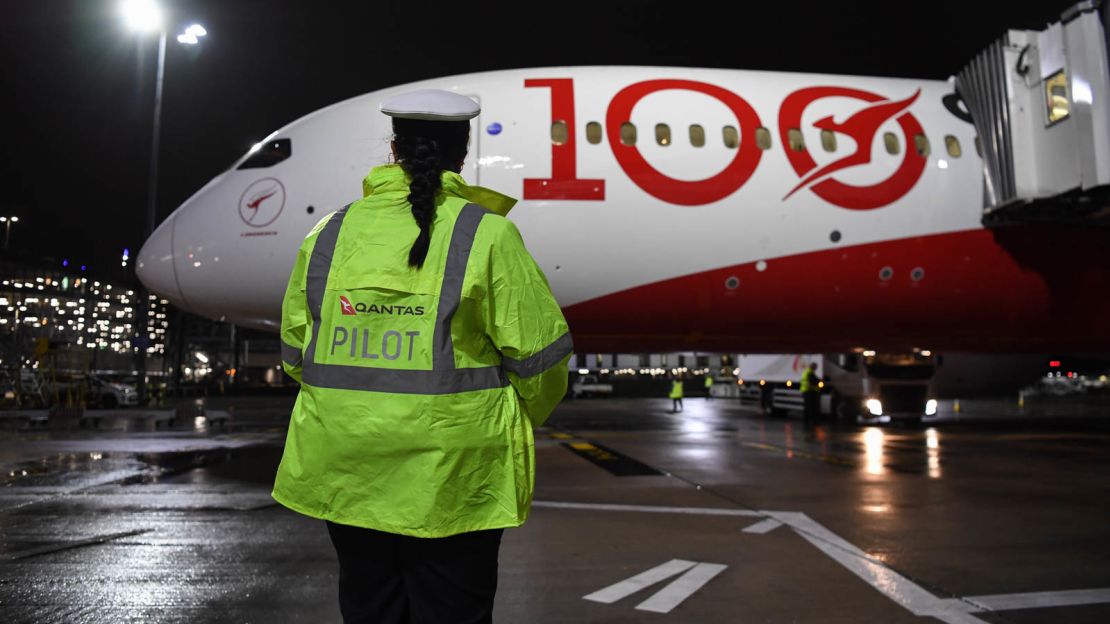
A 6 a.m. departure means showing up at the airport shortly after 4 a.m. – a grim time of day at a UK airport in November. The early slot will allow this unscheduled flight to take off before Heathrow hits peak time and also ensure those on board get to experience two sunrises (and one sunset) in the course of their flight.
Despite dreary weather conditions on the ground, those boarding are clearly excited. There’s a touch of ceremony as the crew, led by Captain Helen Trennery, parade through the departure lounge, shaking hands with CEO Joyce, before heading on board.
Though all today’s passengers are seated in comfy business class seats at the front, they’re instructed to stow bags in the overhead bins at the back. That’s to help balance the airplane and cut down on the nose-heavy drag that will consume more fuel.
That said, the Dreamliner’s gas tanks aren’t full to the brim. As it’s carrying way fewer passengers than its capacity, and should benefit from favorable tailwinds, it can carry less fuel and still get there with at least 90 minutes’ worth to spare.
Hour zero – 6 a.m. London. 5 p.m. Sydney
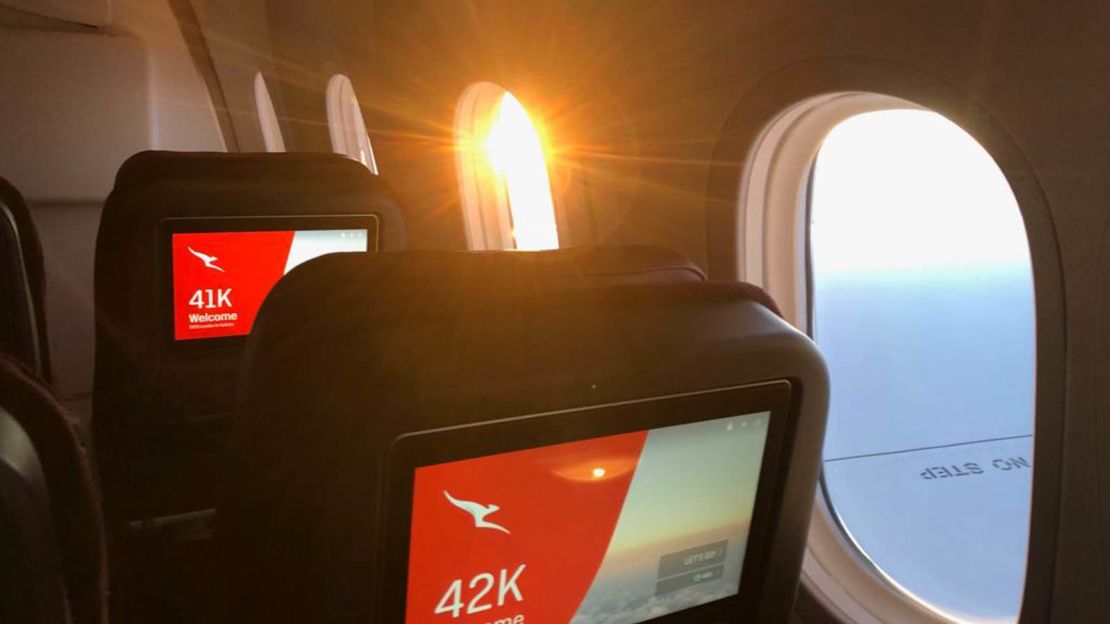
A smooth takeoff on Heathrow’s 27 Left runway sees the plane achieve wheels-up at precisely 6:09 a.m. It sets a course over Northern Europe, heading almost due east.
“I had goosebumps on my arms when we were taking off,” says one of the cabin crew – equally as excited as their passengers at the prospect of being on a landmark flight.
The cabin crew distributes commemorative gray cotton pajamas emblazoned with the words “Qantas Research Flight” and the airline’s kangaroo logo.
As the flight cruises past Berlin, the first sunrise makes a glorious appearance just over the front of the right hand wing at about 6.45 a.m. London time.
Quest’s diary: We leave Heathrow, and before long our first Sunrise peaks over the horizon heralding the start of our first day in the air.
Today’s flight is so long we will experience a double sunrise – it’s a very rare event to see two sunrises of different days on the same flight. Qantas chose the name “Project Sunrise” in honor of clandestine World War II flights that were made from Perth to Sri Lanka en route to London. They were fraught with danger, and lasted so long they saw two sunrises.
Hour one – 7 a.m. London. 6 p.m. Sydney

It’s exercise time. Passengers, some of the press contingent and Qantas staff are led in a series of activities by Professor Corinne Caillaud from the Charles Perkins Centre, a medical institute of the University of Sydney which is carrying out research on the flight.
The empty plane means there’s plenty of room first for walking circuits, then stretches and squats, to help invigorate bodies preparing for another 18 hours in the air.
CEO Joyce manages to restrain himself from instigating a rendition of the Macarena dance – which featured in the New York-Sydney test flight in October.
It’ll be hard to repeat these exercise routines during a full commercial flight, but Caillaud says they’d be valuable for passengers even on shorter journeys.
Quest’s diary: I chatted with pilot in command, Captain Trennery. She performed the take off and will do the landing in Sydney. Planning for this flight took months. I am hoping it will be longer than the New York to Sydney flight time of 16 hours, 16 minutes and claim the record as longest flight time. The captain confirmed it’s looking good to break the record, but says she won’t slow down the plane to stretch it out if it’s close!
Hour two – 8 a.m. London. 7 p.m. Sydney
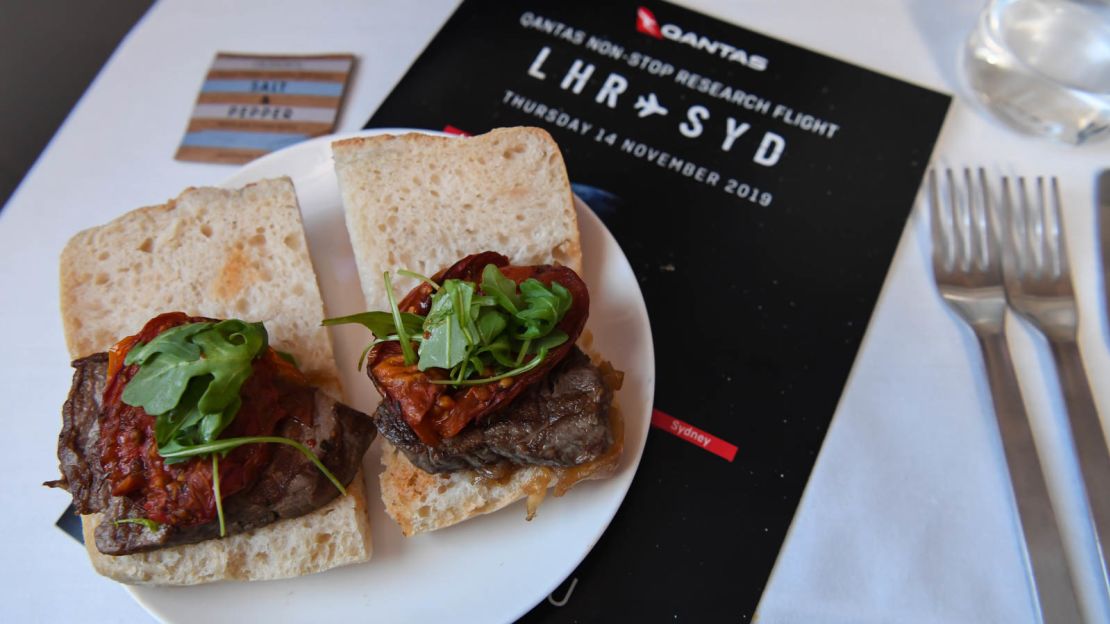
It’s breakfast time in London, but with the plane on Sydney time, the first meal is a carb-loaded, non-spicy supper aimed at lulling diners into a soporific state via their stomachs.
Although the sun is blazing high outside, windows are now shaded and the cabin lights dimmed to mimic the onset of Sydney’s evening. There are a few yawns (although that’s not a surprise given the early morning start).
Beneath the plane, Poland and Belarus slip by.
Quest’s diary: First meal served. Even though properly it is breakfast time in London, in Sydney it’s early evening, so we are being served supper. The selection was carb-heavy, including chicken broth with noodles and a steak sandwich. It’s designed to make us sleepy, helping reset our body clock. Er… I am not sleepy yet, so I start watching the docu-movie “Untouchable” about disgraced producer Harvey Weinstein. I abandon after 16 minutes.
Hour three – 9 a.m. London, 8 p.m. Sydney
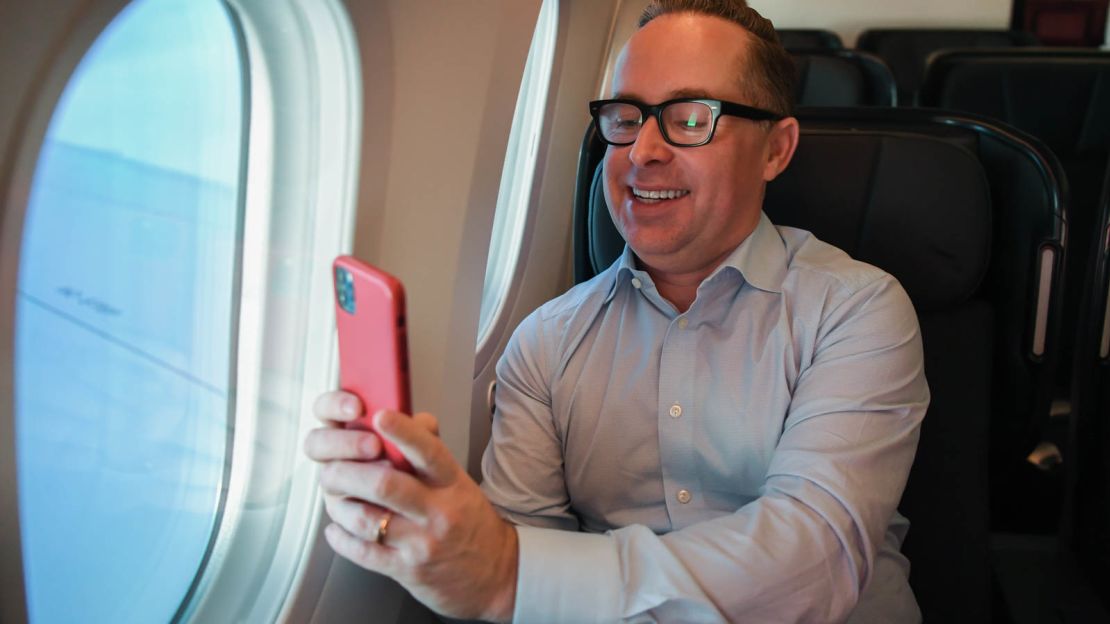
As the cabin begins to settle down for the “evening,” and Russia appears below, CEO Joyce takes a few minutes to chat to some of the journalists on board about Qantas’s program to offset its carbon emissions.
It’s a pertinent discussion when you’re flying a near-empty jet – only 50 of a possible 256 seats were occupied – to the other side of the planet at a time when escalating concerns over the climate crisis are prompting many people to avoid air travel.
Some ultra long haul flights can create more emissions than routes that break up the journey since they have to carry a heavier payload of fuel, although Qantas says the efficient jets it wants to use on the route will be an improvement.
A few days before the departure of the Sydney flight, Qantas announced it was pledging to become a zero carbon emissions airline by 2050 by introducing as-yet unavailable aircraft, aviation tech and sustainable fuel.
Emissions from today’s flight have been offset under Qantas’s own scheme. Such offset programs are criticized for failing to directly address the problem of pollution, but Joyce insists they’re better than nothing until more viable alternatives are available.
Quest’s diary: I gossiped with Qantas CEO Alan Joyce. He isn’t giving anything away about which plane, Airbus’s A350 or Boeing’s 777X-9, he will buy for “Project Sunrise.” The decision is expected sometime next year. Joyce repeats the mantra that Sunrise will only happen if there’s a solid business case. I can’t see them NOT doing it, its just a question of how.
Hour four – 10 a.m. London, 9 p.m. Sydney
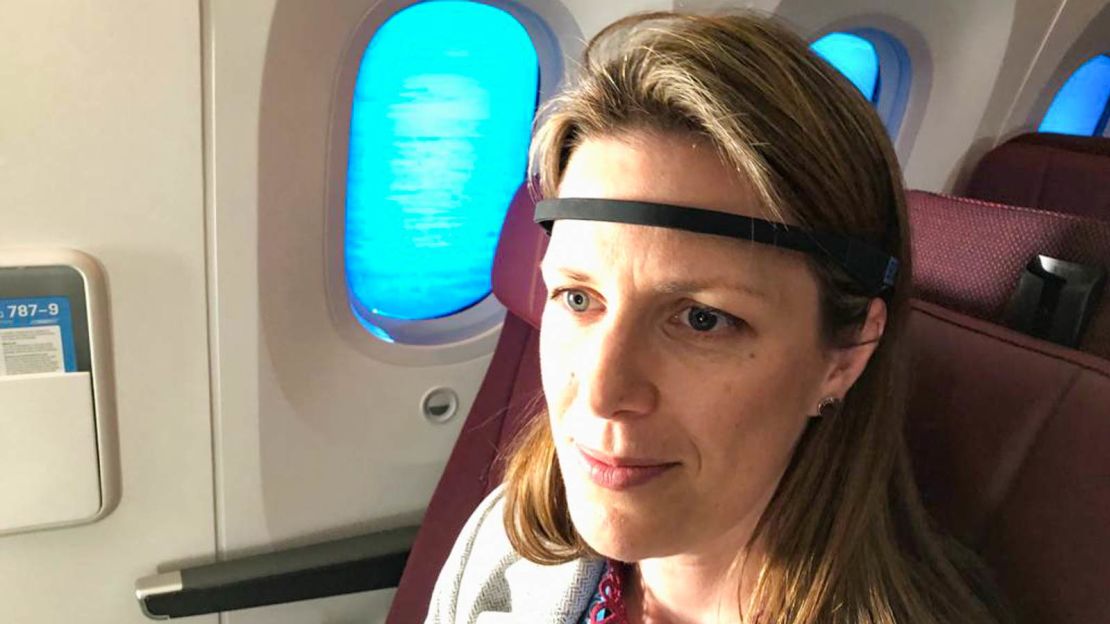
As the plane begins to settle down for the night, Tracey Sletten from Melbourne’s Monash University explains how she’s using wearable sensors to monitor crew brainwaves and physical activity.
The passengers on board who are being monitored are subjected to regimented light patterns to help provide a stable environment for analyzing how their bodies respond to the flight.
Quest’s diary: Lights out! The flight has gone into its dark phase for the next nine hours. Those being monitored start to rest. I should. But I am still not sleepy. Instead I have another go at “Untouchable.” This time I last another 30 minutes. Prefer to daydream out of the window instead.
Hour five – 11 a.m. London, 10 p.m. Sydney
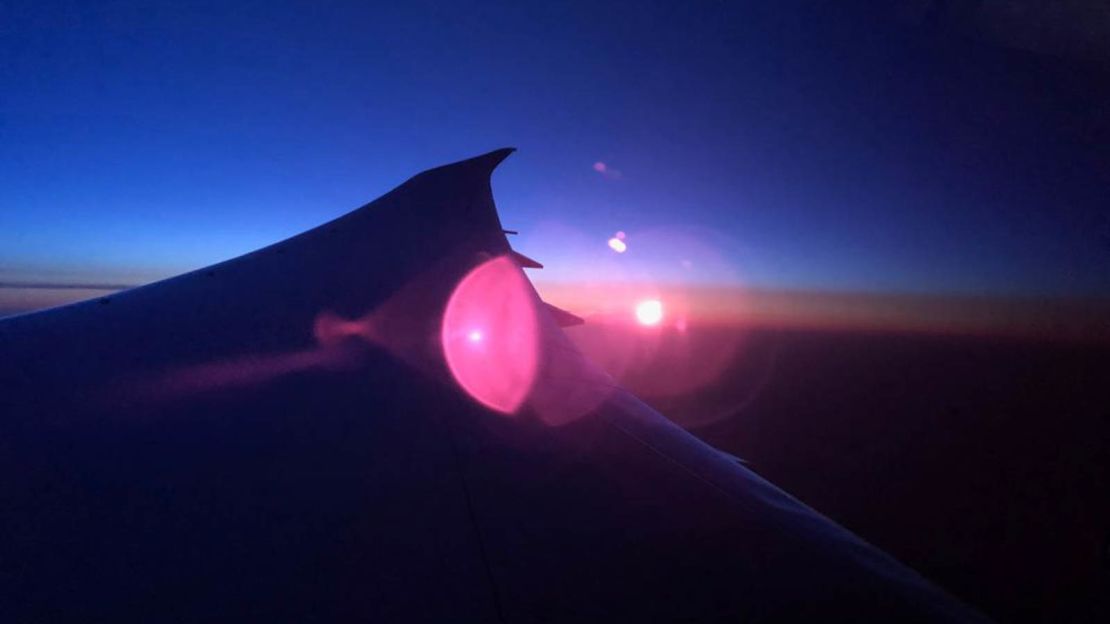
Most passengers are asleep or trying to sleep at this point, which is a shame as they miss sunset as the plane reaches Astana in Kazakhstan. A glowing orange orb plummets fast towards the horizon off the right-hand wing tip shortly after 11.45 a.m. London time.
Through the night, the route will fly eastwards, crossing over into China where it begins turning southwards. The Dreamliner will spend nearly five hours in Chinese airspace, before heading out to sea over Hong Kong.
The route, designed to optimize fuel, is an unusual one for Qantas. Captain Trennery said earlier that crossing into unfamiliar air spaces was one of the biggest challenges of the flight.
Qantas has flown London to Sydney direct, back in 1989. Back then, it used a Boeing 747 that had most of its internal furniture removed to cut down on weight and fuel tanks filled to the brim to carry just 23 people.
The course it took then was more southerly, because it didn’t have the airspace permissions it needed to fly the more economical route.
Quest’s diary: I fell asleep. I had to get up at 2 a.m. London time to make this flight.
Finally exhaustion won.
Hour six – noon London, 11 p.m. Sydney
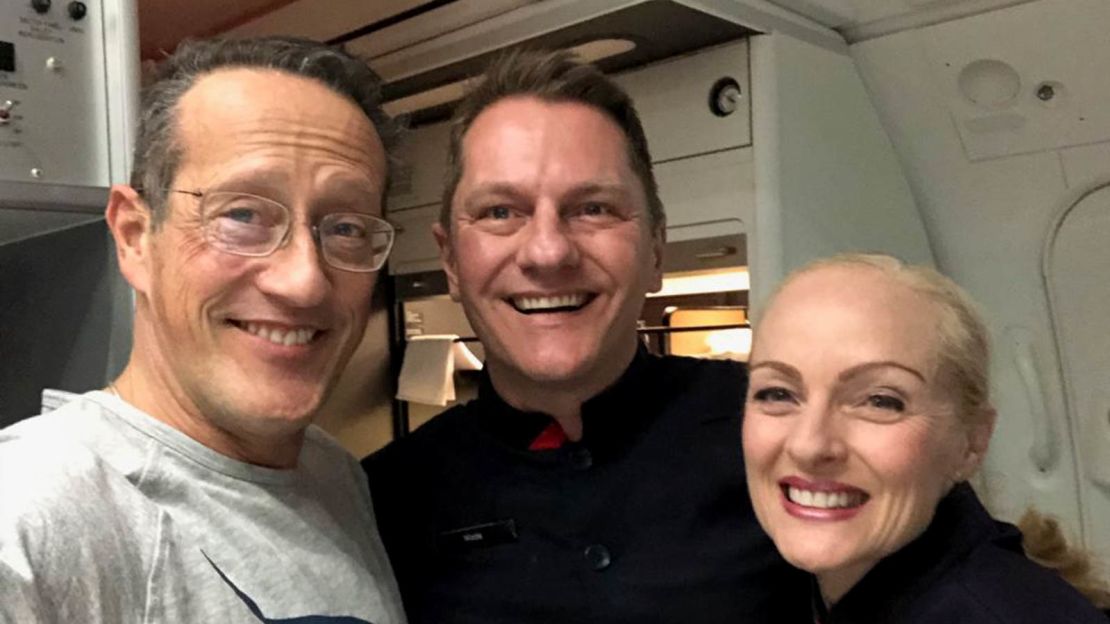
All is quiet. The cabin crew keep watch, serving occasional cups of tisane – a herbal tea aimed at promoting sleep – to those unable to grab some shuteye.
The cabin team do get to take a break. There’re six bunks at the rear of the plane to allow them, and the aircraft’s four pilots, to take turns to rest and try to sleep.
Quest’s diary: Asleep. The Qantas business seat is excellent. Lots of room at the shoulder and foot well – the Achilles heel of most business seats (oh c’mon, that was pretty good, especially after seven hours of flying.)
Hour seven – 1 p.m. London, midnight Sydney
QF7879 makes its way across western China, still in darkness.
We’re now heading into Friday, Sydney time, bringing to a close a day that lasted just 13 hours for those on board.
Quest’s diary: Woke up and decided a cup of tea and a cookie would be nice. Unlike the rest of the passengers who are turning their body clock, I need to work immediately in Sydney so will do the bulk of my sleep later on, if I can. Tea and cookies arrive. Can’t face “Untouchable,” so I’ll doze.
Hour eight – 2 p.m. London, 1 a.m. Sydney
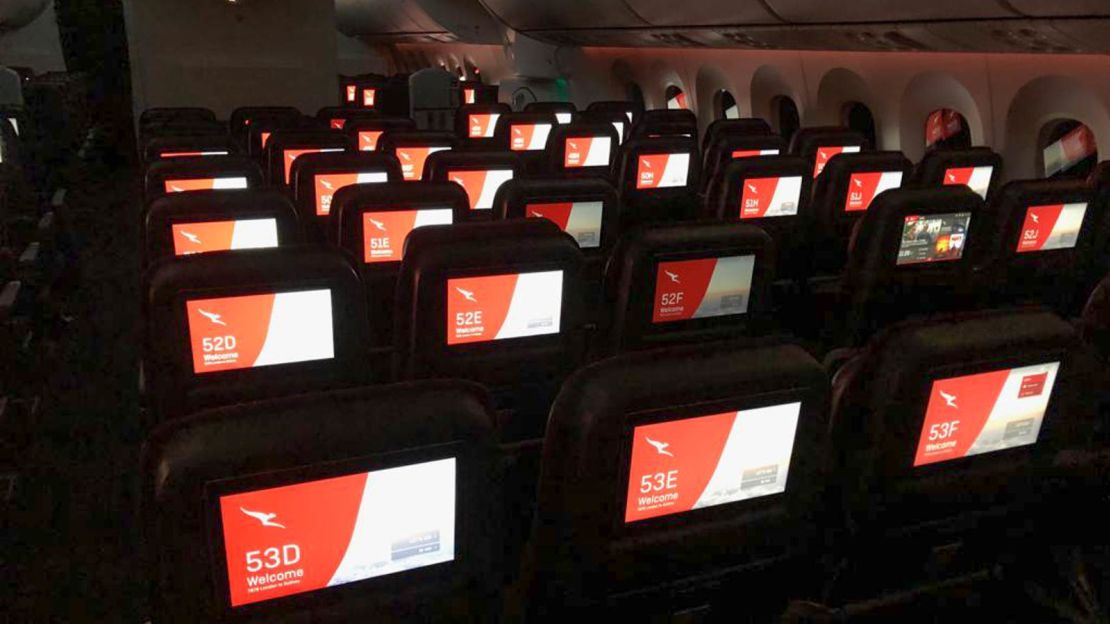
Most of the passengers are making use of their fully reclining beds in business class, although one takes up residence in economy, lying flat across three seats.
For much of the night she’s the sole occupant of a space that can accommodate more than 150 people.
Quest’s diary: We are nearly halfway there. Everyone around me is asleep. Time to work. I am writing about jet lag. The jet lag science and work being done on this flight is fascinating. I can’t avoid jet lag, but I can mitigate it.
Hour nine – 3 p.m. London, 2 a.m. Sydney
Most of the plane is still asleep, or trying to sleep. The lucky ones have cheated their body clocks and snatched a few hours. The unlucky ones are still on UK time, which is fine for now, but when the Australian morning hits, it’s going to hurt.
Quest’s diary: This is the halfway point, over China. This unique flight required special overflight permission from various governments including China, Kazakhstan and Russia. One of the countries only gave permission 36 hours before departure, giving some anxious moments at Qantas HQ!
Hour 10 – 4 p.m. London, 3 a.m. Sydney
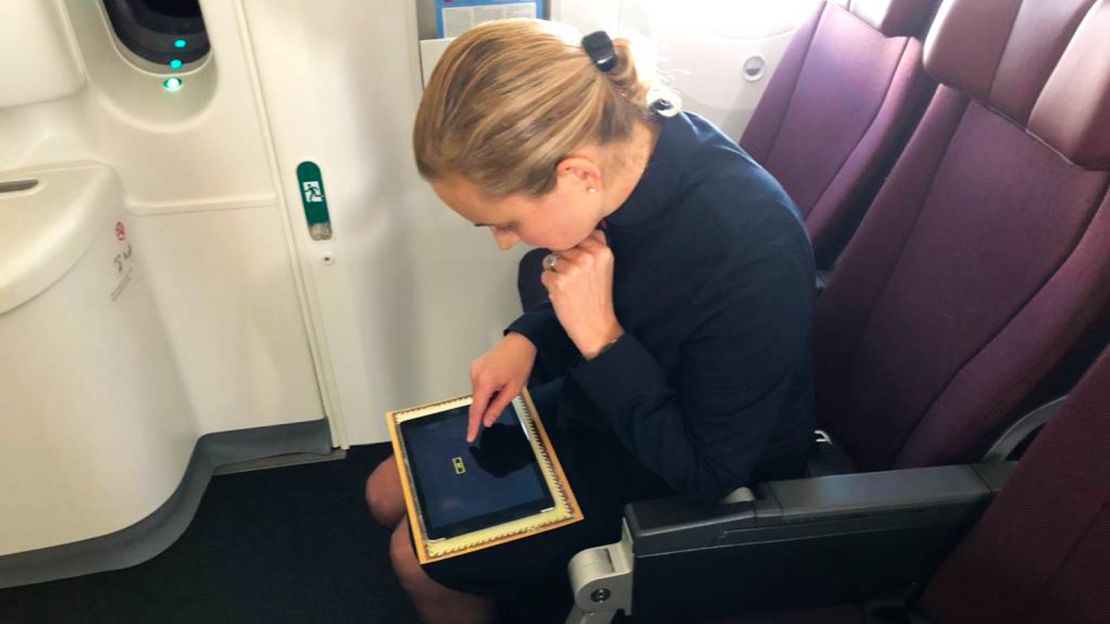
Nothing much happens at this point, although the true extent of the endurance required for flying 19-plus hours is becoming evident.
The plane is now out over the South China Sea, heading towards the Philippines and there’s still the equivalent of a London to New York flight ahead.
Quest’s diary: I decided I needed to get some more sleep if disaster was to be averted later. I started off trying to keep track of London time, then decided to move to Sydney time. Now I have hopelessly failed to keep track of what time is where. watching the clock. Biggest surprise is I feel good.
Hour 11 – 5 p.m. London, 4 a.m. Sydney
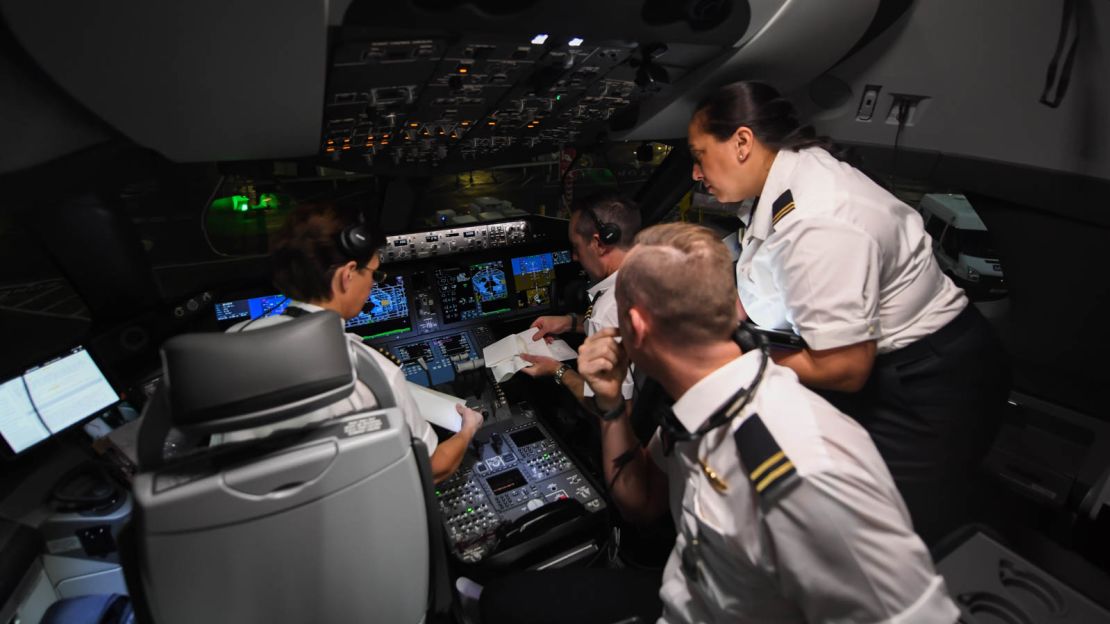
All is still quiet on board the QF7879. Occasionally, throughout these sleepy moments, a crew member can be seen heading to the restrooms in the middle of the airplane, which are off limits to the rest of the passengers due to two words: urine samples.
Quest’s diary: I take a walk around the empty economy section at the back. It’s spooky – rows and rows of empty seats, like a ghost flight through the night.
Nineteen hours in, these seats with a full cabin would not be fun. Thankfully Qantas has said the final “Project Sunrise” flights will have roomier seats in economy offering more space.
Hour 12 – 6 p.m. London, 5 a.m. Sydney
Still nothing happens. The flight is making good progress though. The captain reveals later that the airplane has been handling better than expected, so fuel reserves should exceed the 90-minutes’ worth of excess it was expected to land with.
Quest’s diary: I couldn’t fall back to sleep, Instead I went to visit the galley. The crew tell me the biggest challenge on ultra long haul flights is managing their fatigue and stamina. My guess is they are perpetually jet lagged. The plane is bouncing about a bit. It will take some time for my inner ear to adjust when on the ground – sure enough later, after we arrive in Sydney, I can still feel the room swaying.
Hour 13 – 7 p.m. London, 6 a.m. Sydney
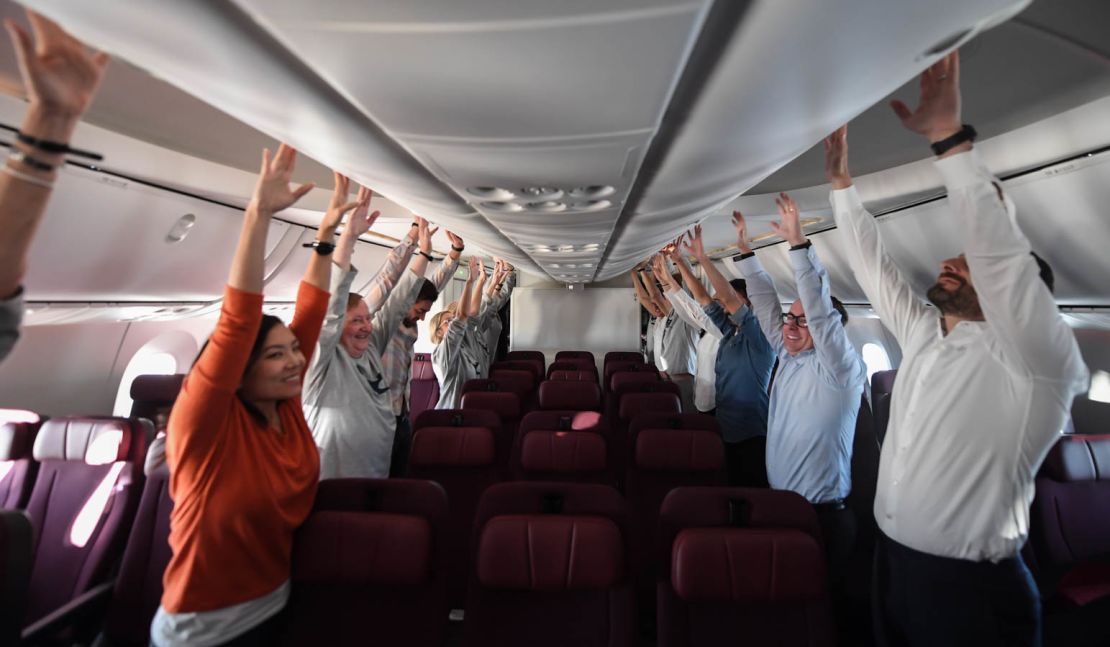
The plane starts to rouse in anticipation of greeting its second dawn. Shots of coffee or some sort of spinach-based concoction are offered to passengers just before the cabin lights go up.
Heads bob up and down in the aisles of economy as Professor Caillaud leads passengers in more exercises.
Quest’s diary: It’stime for passengers on QF7879 to wake up. The lights go on, I am left in no doubt, the day has begun! Boeing’s engineers on board tell me good winds and routes means fuel use is better than expected.
Hour 14 – 8 p.m. London, 7 a.m. Sydney
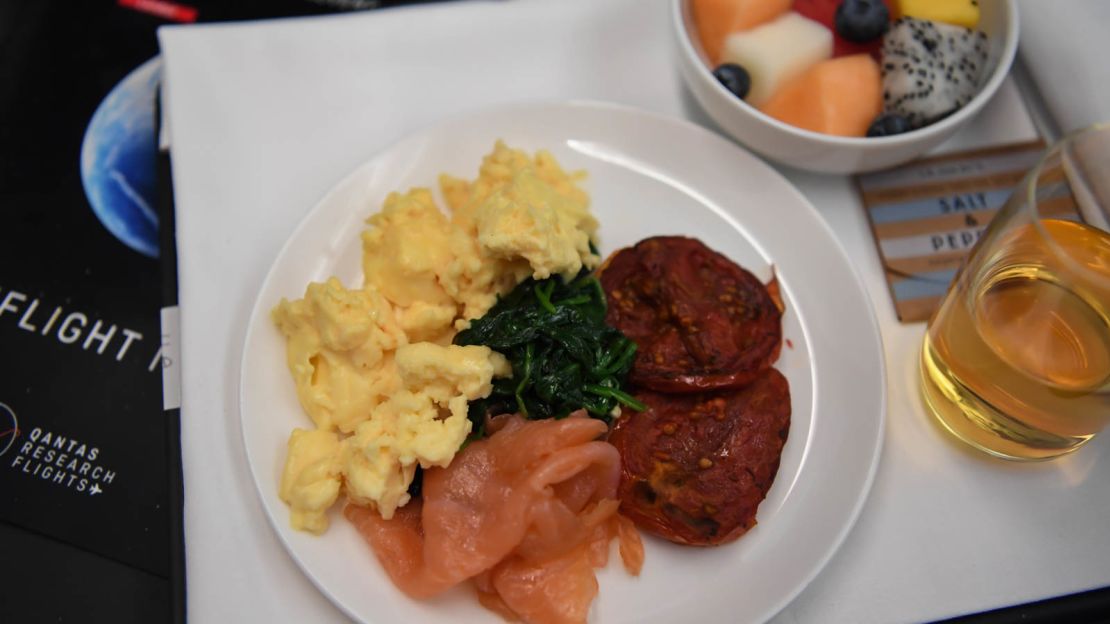
Breakfast time. Plenty of people say they feel surprisingly good – but then again it’s still only early evening in London.
Quest’s diary: Our second meal is served: Breakfast, even though my body says it should be dinner. Not sure this time shifting is going well with my insides. I have the scrambled eggs and smoked salmon along with two helpings of Bircher muesli and fresh fruit. This long-distance flying is hungry stuff.
Hour 15 – 9 p.m. London, 8 a.m. Sydney
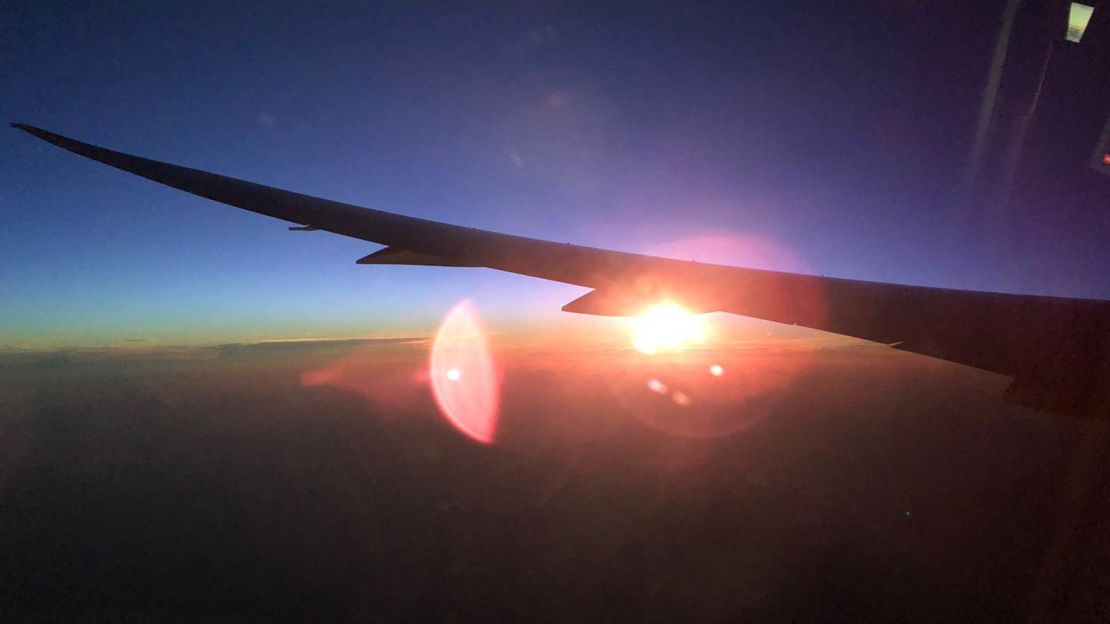
After several hours of flying over the vast Philippines archipelago, QF7879 encounters the sun once again as it flies over the Indonesian city of Ambon. Dawn breaks on the left-hand side of the plane, sending strong shafts of orange light through the cabin.
Captain Trennery announces that all on board have become certified members of the Secret Order of the Double Sunrise, a designation originally awarded to the World War II pilots flying long haul missions that took them through a double dawn.
Quest’s diary: The double sunrise! Magic. We have been in the air so long we saw the sunrise heralding Europe’s Thursday. Since then we flew on through the day and all night. Now sunrise for Friday comes over the Philippines. Apparently fewer than 1,000 people have experienced double sunrises!
Hour 16 – 10 p.m. London, 9 a.m. Sydney
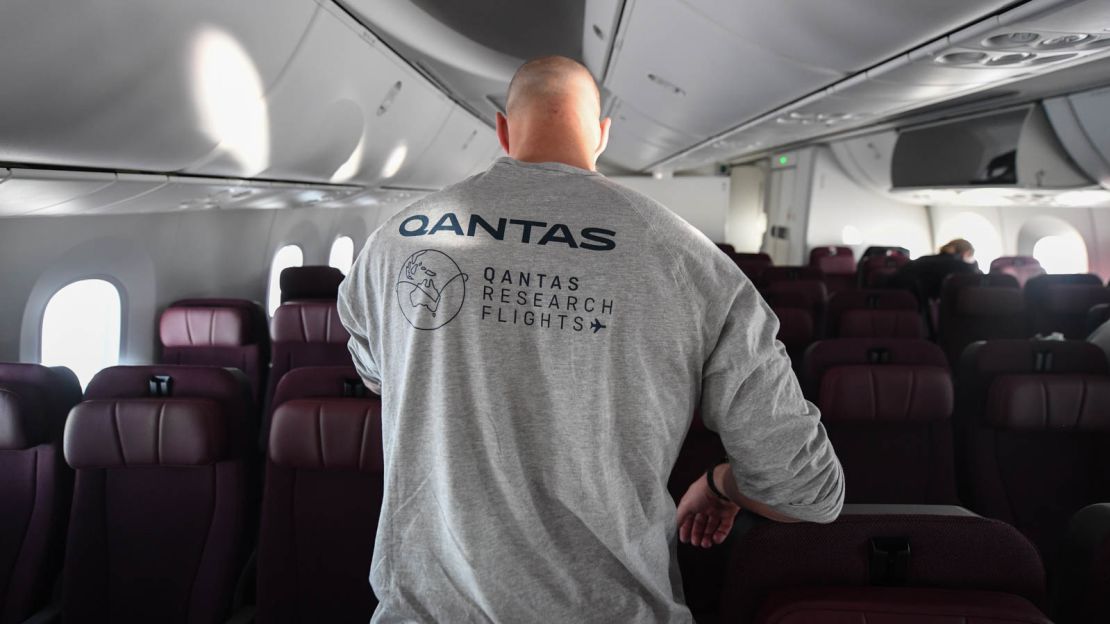
A final round of exercise is led by Professor Caillaud in economy class. By now there’s only a hardcore few joining the session, the rest having succumbed to fatigue, cabin fever, off-program sleep or the inflight entertainment.
Passengers begin changing out of their Qantas pajamas and back into more businesslike attire in anticipation of the ceremony that awaits them in Sydney.
At last QF7879 reaches Australia, hitting the mainland near the tropical northern city of Darwin. There’s still well over three hours of flying time left on the clock. Right now, that seems like a very long three hours.
Quest’s diary: We have crossed the northern coast of Australia, and passed over Darwin and the top. Starting to hear rumors that we might not beat the NY-SYD time after all. I spoke to Captain Trennery and tried to convince her to slow the plane down. She gave me an old fashioned look that left me in no doubt: this captain won’t be a co-conspirator to beat the record! I retreated back to seat 10K with tail between legs.
Hour 17 – 11 p.m London, 10 a.m. Sydney
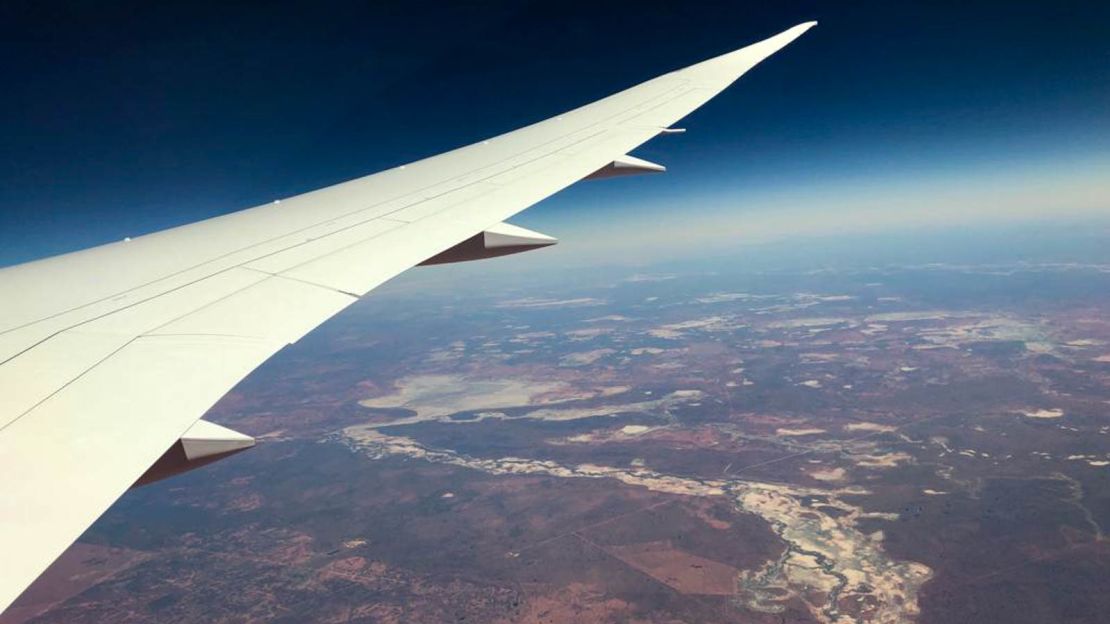
There’s a palpable sense that people are keen to see the end of the flight. They want off as soon as possible.
Below, the hot Australian outback drifts by.
Roslyn Osborne, a Qantas frequent flier drafted onto the flight as a research guinea pig, says she’s managed about four hours of sleep, and the regular exercises have left her feeling “oxygenated, energized.” She adds: “Without it, I’d feel dopey.”
Quest’s diary: More food is served. A light lunch. My body doesn’t care now – food is food and my chicken salad with quinoa might as easily have been lunch, dinner or a late-night snack.
I am feeling guilty about “Untouchable” so give it another go.
Hour 18 – Midnight London, 11 a.m. Sydney
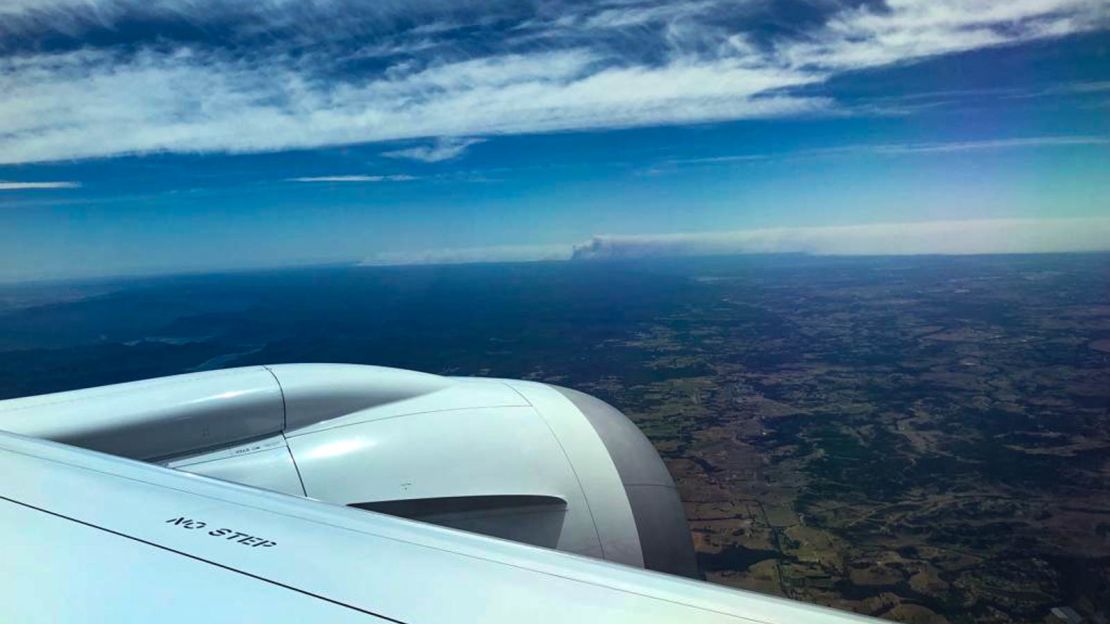
The flight noses towards the eastern coast of Australia. Preparations for arrival begin, but given the very small number of passengers, it’s a relatively relaxed affair compared to the usual frenetic operation on board a standard commercial flight.
Quest’s diary: “Untouchable” is excellent, but I am now in the last hour before landing (I can watch the rest on the way home). Now we are busily working out just how close a call it will be to get the record. Suddenly there is Sydney on the horizon. We pause in respect as we see the haze from the current bush fires devastating large parts of New South Wales.
Hour 19: – 1 a.m. London, 12 a.m Sydney
The Dreamliner swoops down over the coast and out to sea, banking and looping back to line up for Sydney Airport. There’s a last minute scramble as some of the passengers switch seats to get the best view for landing.
Quest’s diary: Minutes to go…QF7879 Is on final approach. Front slats deployed. Flaps lowered in stages. Gear down. Captain Trennery is flying the plane manually.
Hour 19 plus 19 minutes
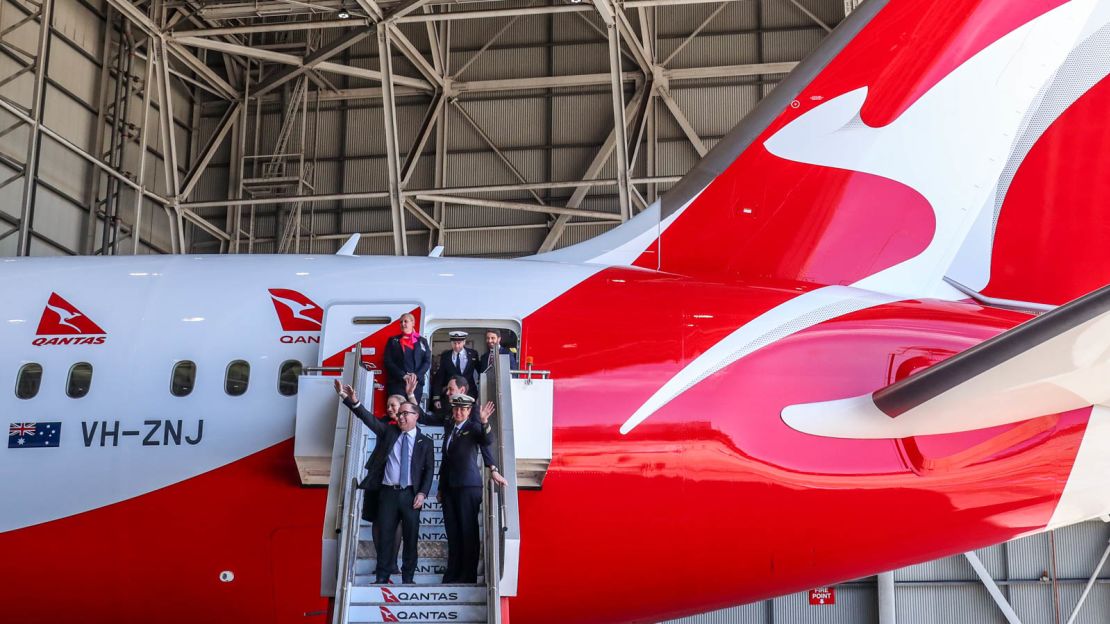
The plane lands smoothly and taxis gently towards a gigantic Qantas hangar where a crowd of the airline’s employees has gathered to celebrate its arrival. The plane is held outside for a few minutes to allow a choir to finish its performance.
It finally enters and the flight is over.
Quest’s diary: We touch down at SYD We have flown 17,800 kilometers, that’s 11,000 miles. We have smashed the distance record set by the NY/SYD flight and beaten that flight’s longest time by three minutes!
Time for sleep. In a bed. Before I fly back, tomorrow.



















